Page 1956 of 4171

EXL-8
< FUNCTION DIAGNOSIS >
HEADLAMP
A Xenon type headlamp is adapted to the low beam headlamps. Xenon bulbs do not use a filament. Instead,
they produce light when a high voltage current is pa ssed between two tungsten electrodes through a mixture
of Xenon (an inert gas) and certain other metal halides. In addition to added lighting power, electronic control
of the power supply gives the headlamps stable quality and tone color. Following are some of the advantages
of the Xenon type headlamp.
• The light produced by the headlamps is a white color comparable to sunlight that is easy on the eyes.
• Light output is nearly double that of halogen headlamps, affording increased area of illumination.
• The light features a high relative spectral distribution at wavelengths to which the human eye is most sensi- tive. This means that even in the rain, more light is reflected back from the road surface toward the vehicle,
for added visibility.
• Power consumption is approximately 25 percent less than halogen headlamps, reducing battery load.
HIGH BEAM OPERATION/FLASH-TO-PASS OPERATION
With the combination switch (lighting and turn signal switch) in the 2ND position and placed in HIGH position,
the BCM receives input requesting the headlamp high beams to illuminate. The flash to pass feature can be
used any time and also sends a signal to the BCM. This input is communicated to the IPDM E/R via the CAN
communication lines. The CPU of the combination meter c ontrols the ON/OFF status off the HIGH BEAM indi-
cator. The CPU of the IPDM E/R controls the headlamp LH high and RH high relay coils which supplies power
to the high beam headlamps.
The combination meter receives a high beam request signal (ON) via the CAN communication lines and turns
the high beam indicator lamp ON.
Revision: December 20092009 QX56
Page 1957 of 4171
DAYTIME LIGHT SYSTEMEXL-9
< FUNCTION DIAGNOSIS >
C
DE
F
G H
I
J
K
M A
B
EXL
N
O P
DAYTIME LIGHT SYSTEM
System DiagramINFOID:0000000003776148
System DescriptionINFOID:0000000003776149
The headlamp system for Canada vehicles is equipped with a daytime light control unit that activates the high
beam headlamps at approximately half illumination whenever the engine is operating. If the parking brake is
applied before the engine is started the daytime lights will not be illuminated. The daytime lights will illuminate
once the parking brake is released. Thereafter, the daytime lights will continue to operate when the parking
brake is applied.
Component Parts LocationINFOID:0000000003776150
AWLIA1596GB
AWLIA1626ZZ
Revision: December 20092009 QX56
Page 1958 of 4171

EXL-10
< FUNCTION DIAGNOSIS >
DAYTIME LIGHT SYSTEM
Component Description
INFOID:0000000003776151
After starting the engine with the parking brake released and the lighting switch in the OFF or 1ST position, the
headlamp high beam automatically turns on at a reduced intensity. With the lighting switch in the 2nd position
or with autolamps ON, the headlamps function the same as conventional light systems.
OPERATION
The BCM monitors inputs from the parking brake switch and the combination switch to determine when to acti-
vate the daytime light system. The BCM sends a dayti me light request to the IPDM E/R via the CAN commu-
nication lines. The IPDM E/R grounds the daytime light relay which in turn, provides power to the ground side
of the LH high beam lamp. Power flows backward through the LH high beam lamp to the IPDM E/R, through
the high beam fuses, through the RH high beam lamp circuit to the RH high beam lamp and on to ground. The
high beam lamps are wired in series which causes them to illuminate at a reduced intensity.
1. IPDM E/R E119, E122, E123, E124 2. BCM M18, M20 (view with instrument
panel removed)3. Daytime running light relay E103
4. Combination switch M28 5. Combination meter M23, M24 6. Parking brake switch M11
Revision: December 20092009 QX56
Page 1959 of 4171
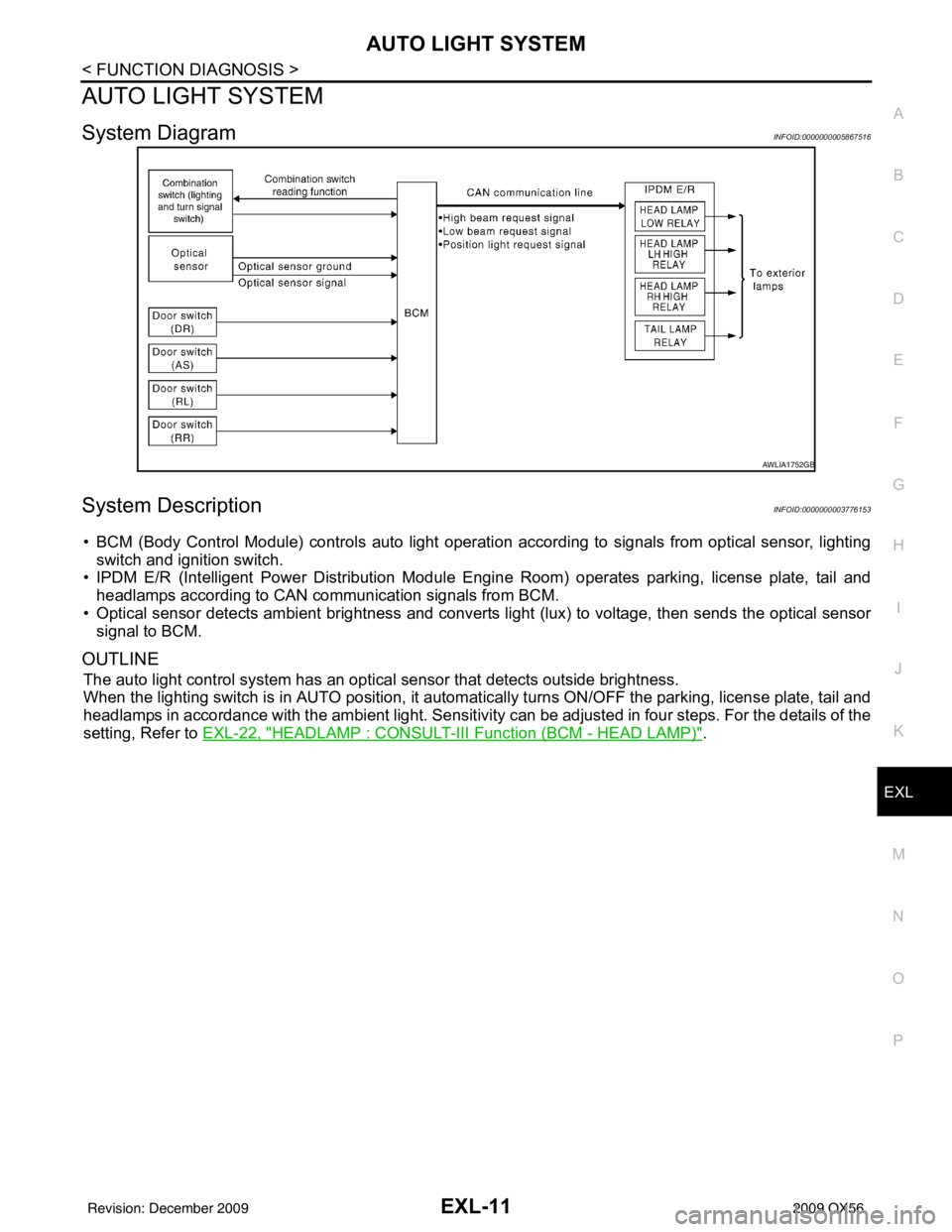
AUTO LIGHT SYSTEMEXL-11
< FUNCTION DIAGNOSIS >
C
DE
F
G H
I
J
K
M A
B
EXL
N
O P
AUTO LIGHT SYSTEM
System DiagramINFOID:0000000005867516
System DescriptionINFOID:0000000003776153
• BCM (Body Control Module) controls auto light operati on according to signals from optical sensor, lighting
switch and ignition switch.
• IPDM E/R (Intelligent Power Distribution Module Engine Room) operates parking, license plate, tail and
headlamps according to CAN communication signals from BCM.
• Optical sensor detects ambient br ightness and converts light (lux) to voltage, then sends the optical sensor
signal to BCM.
OUTLINE
The auto light control system has an optical sensor that detects outside brightness.
When the lighting switch is in AUTO position, it automat ically turns ON/OFF the parking, license plate, tail and
headlamps in accordance with the ambient light. Sensitivity can be adjusted in four steps. For the details of the
setting, Refer to EXL-22, "
HEADLAMP : CONSULT-III F unction (BCM - HEAD LAMP)".
AWLIA1752GB
Revision: December 20092009 QX56
Page 1960 of 4171
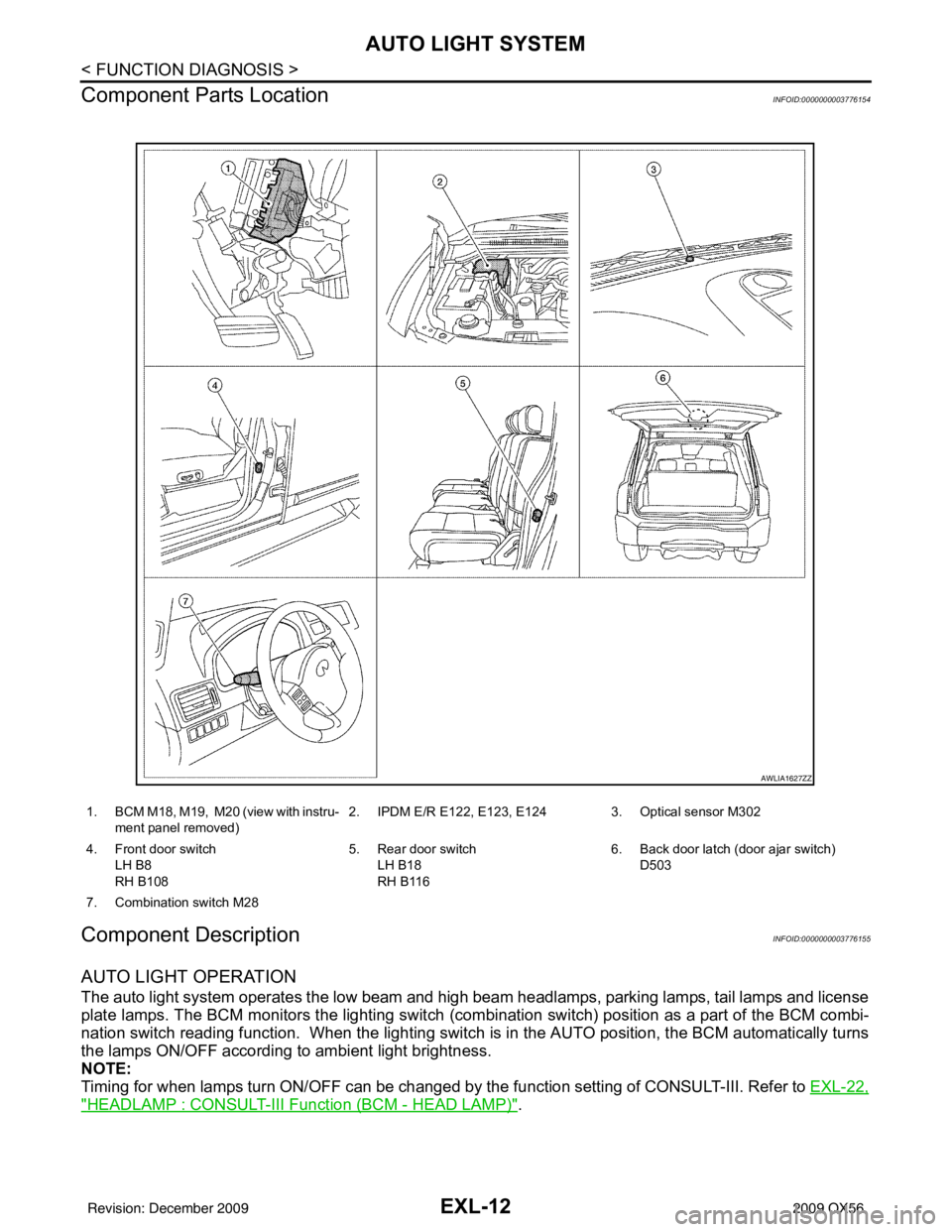
EXL-12
< FUNCTION DIAGNOSIS >
AUTO LIGHT SYSTEM
Component Parts Location
INFOID:0000000003776154
Component DescriptionINFOID:0000000003776155
AUTO LIGHT OPERATION
The auto light system operates t he low beam and high beam headlamps, parking lamps, tail lamps and license
plate lamps. The BCM monitors the lighting switch (com bination switch) position as a part of the BCM combi-
nation switch reading function. When the lighting switch is in the AUTO position, the BCM automatically turns
the lamps ON/OFF according to ambient light brightness.
NOTE:
Timing for when lamps turn ON/OFF can be changed by the function setting of CONSULT-III. Refer to EXL-22,
"HEADLAMP : CONSULT-III Function (BCM - HEAD LAMP)".
1. BCM M18, M19, M20 (view with instru-
ment panel removed) 2. IPDM E/R E122, E123, E124 3. Optical sensor M302
4. Front door switch LH B8
RH B108 5. Rear door switch
LH B18
RH B116 6. Back door latch (door ajar switch)
D503
7. Combination switch M28
AWLIA1627ZZ
Revision: December 20092009 QX56
Page 1961 of 4171
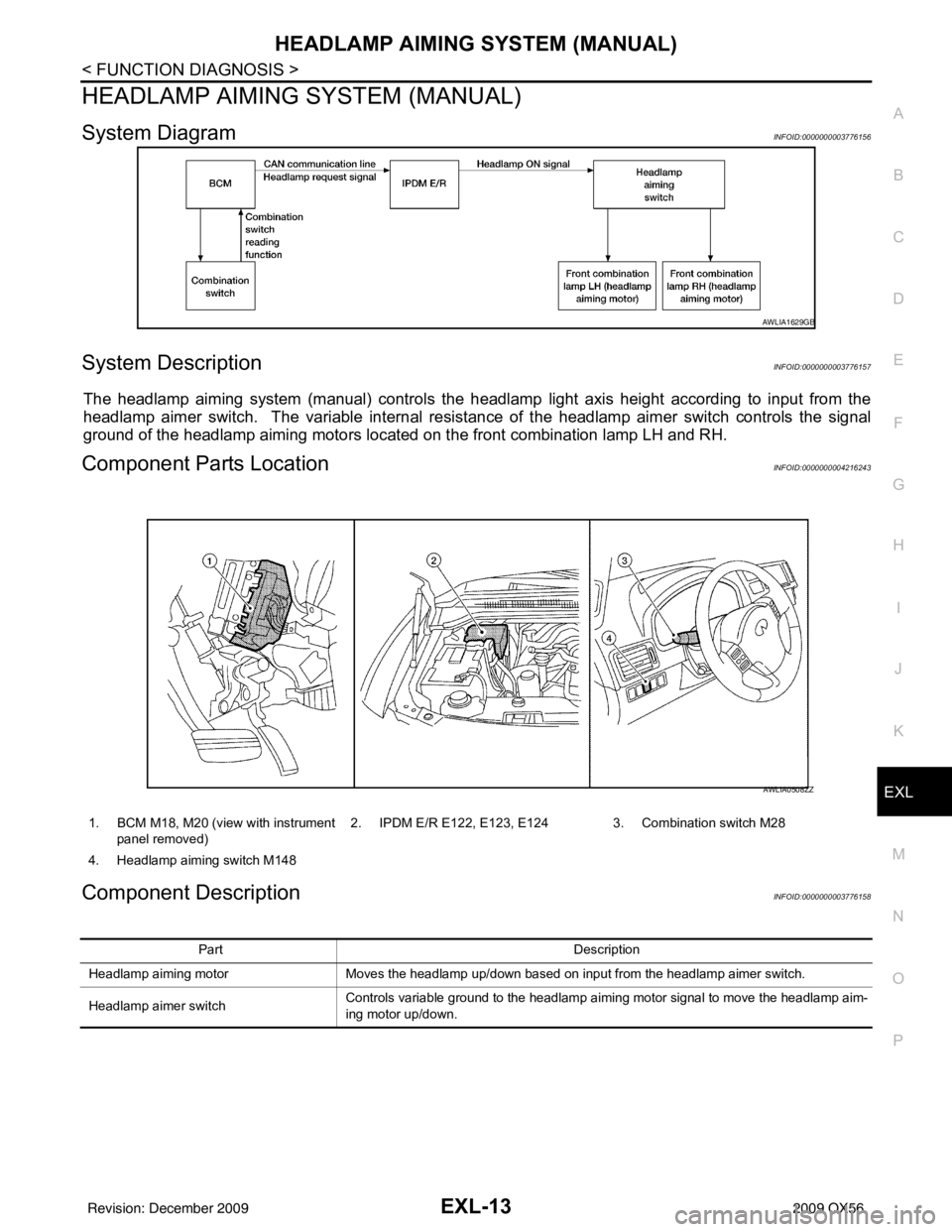
HEADLAMP AIMING SYSTEM (MANUAL)EXL-13
< FUNCTION DIAGNOSIS >
C
DE
F
G H
I
J
K
M A
B
EXL
N
O P
HEADLAMP AIMING SYSTEM (MANUAL)
System DiagramINFOID:0000000003776156
System DescriptionINFOID:0000000003776157
The headlamp aiming system (manual) controls the headlamp light axis height according to input from the
headlamp aimer switch. The variable internal resist ance of the headlamp aimer switch controls the signal
ground of the headlamp aiming motors located on the front combination lamp LH and RH.
Component Parts LocationINFOID:0000000004216243
Component DescriptionINFOID:0000000003776158
AWLIA1629GB
1. BCM M18, M20 (view with instrument
panel removed) 2. IPDM E/R E122, E123, E124 3. Combination switch M28
4. Headlamp aiming switch M148
AWLIA0508ZZ
Part Description
Headlamp aiming motor Moves the headlamp up/down based on input from the headlamp aimer switch.
Headlamp aimer switch Controls variable ground to the headlamp aiming motor signal to move the headlamp aim-
ing motor up/down.
Revision: December 20092009 QX56
Page 1962 of 4171
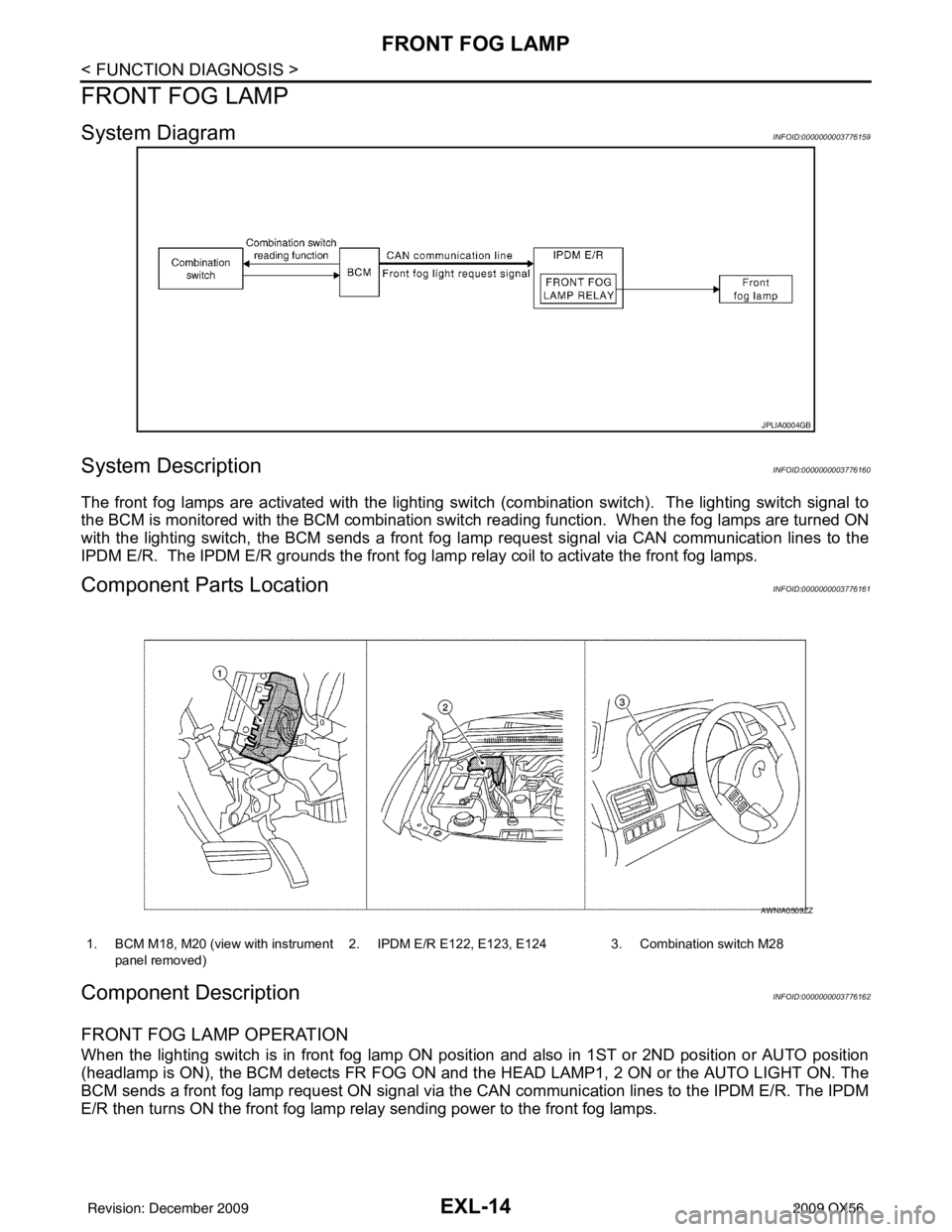
EXL-14
< FUNCTION DIAGNOSIS >
FRONT FOG LAMP
FRONT FOG LAMP
System DiagramINFOID:0000000003776159
System DescriptionINFOID:0000000003776160
The front fog lamps are activated with the lighting switch (combination switch). The lighting switch signal to
the BCM is monitored with the BCM combination swit ch reading function. When the fog lamps are turned ON
with the lighting switch, the BCM sends a front fog la mp request signal via CAN communication lines to the
IPDM E/R. The IPDM E/R grounds the front fog la mp relay coil to activate the front fog lamps.
Component Parts LocationINFOID:0000000003776161
Component DescriptionINFOID:0000000003776162
FRONT FOG LAMP OPERATION
When the lighting switch is in front fog lamp ON posit ion and also in 1ST or 2ND position or AUTO position
(headlamp is ON), the BCM detects FR FOG ON and the HEAD LAMP1, 2 ON or the AUTO LIGHT ON. The
BCM sends a front fog lamp request ON signal via the CAN communication lines to the IPDM E/R. The IPDM
E/R then turns ON the front fog lamp relay sending power to the front fog lamps.
JPLIA0004GB
1. BCM M18, M20 (view with instrument
panel removed) 2. IPDM E/R E122, E123, E124 3. Combination switch M28
AWNIA0509ZZ
Revision: December 20092009 QX56
Page 1963 of 4171
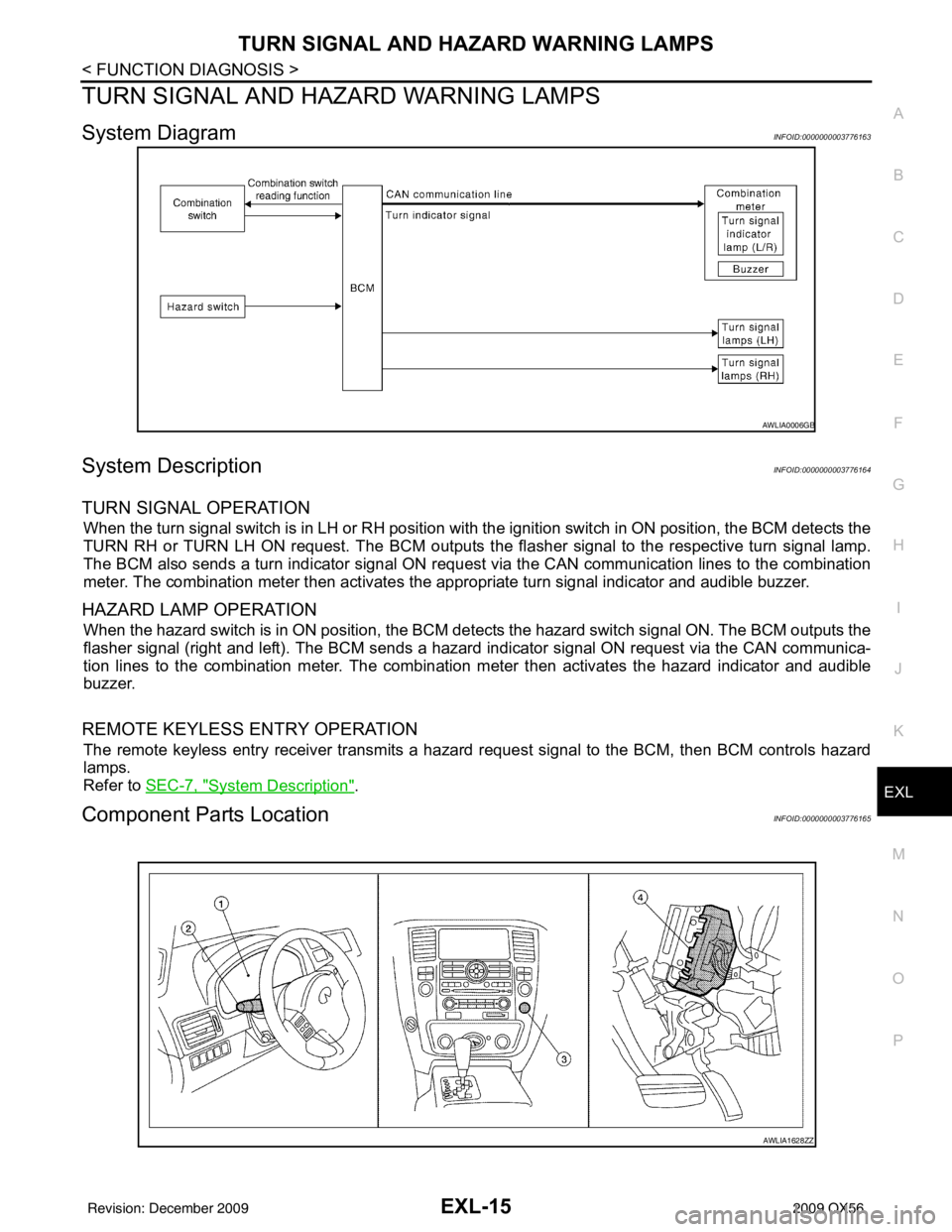
TURN SIGNAL AND HAZARD WARNING LAMPSEXL-15
< FUNCTION DIAGNOSIS >
C
DE
F
G H
I
J
K
M A
B
EXL
N
O P
TURN SIGNAL AND HA ZARD WARNING LAMPS
System DiagramINFOID:0000000003776163
System DescriptionINFOID:0000000003776164
TURN SIGNAL OPERATION
When the turn signal switch is in LH or RH position with the ignition switch in ON position, the BCM detects the
TURN RH or TURN LH ON request. The BCM outputs the fl asher signal to the respective turn signal lamp.
The BCM also sends a turn indicator signal ON reques t via the CAN communication lines to the combination
meter. The combination meter then activates the appropriate turn signal indicator and audible buzzer.
HAZARD LAMP OPERATION
When the hazard switch is in ON position, the BCM detects the hazard switch signal ON. The BCM outputs the
flasher signal (right and left). The BCM sends a hazar d indicator signal ON request via the CAN communica-
tion lines to the combination meter. The combinati on meter then activates the hazard indicator and audible
buzzer.
REMOTE KEYLESS ENTRY OPERATION
The remote keyless entry receiver transmits a hazard request signal to the BCM, then BCM controls hazard
lamps.
Refer to SEC-7, "
System Description".
Component Parts LocationINFOID:0000000003776165
AWLIA0006GB
AWLIA1628ZZ
Revision: December 20092009 QX56